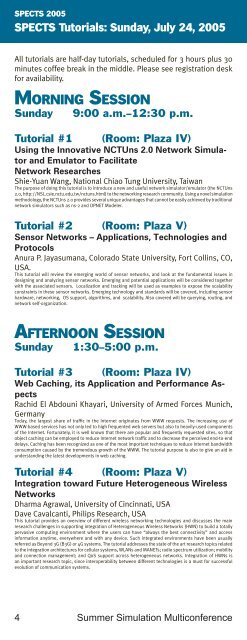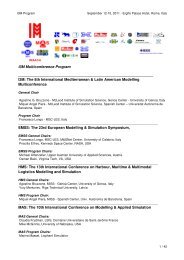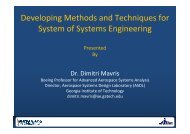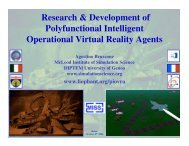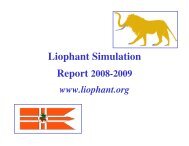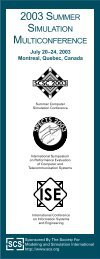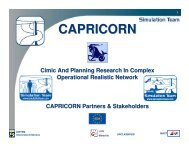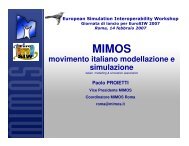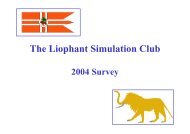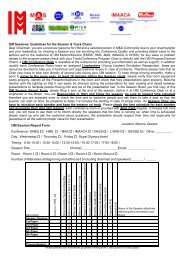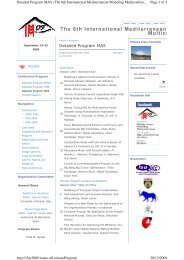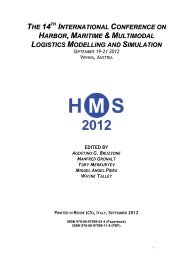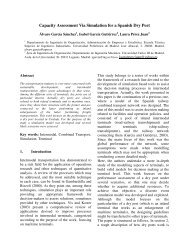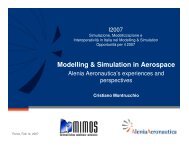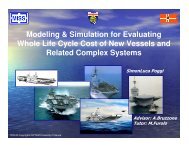SPECTS 2005SPECTS Tutorials: Sunday, July 24, 2005All tutorials are half-day tutorials, scheduled for 3 hours plus 30minutes coffee break in the middle. Please see registration deskfor availability.MORNING SESSIONSunday 9:00 a.m.–12:30 p.m.Tutorial #1 (Room: Plaza IV)Using the Innovative NCTUns 2.0 Network Simulatorand Emulator to FacilitateNetwork ResearchesShie-Yuan Wang, National Chiao Tung University, TaiwanThe purpose of doing this tutorial is to introduce a new and useful network simulator/emulator (the NCTUns2.0, http://NSL.csie.nctu.edu.tw/nctuns.html) to the networking research community. Using a novel simulationmethodology, the NCTUns 2.0 provides several unique advantages that cannot be easily achieved by traditionalnetwork simulators such as ns-2 and OPNET Modeler.Tutorial #2 (Room: Plaza V)Sensor Networks – Applications, Technologies andProtocolsAnura P. Jayasumana, Colorado State University, Fort Collins, CO,USA.This tutorial will review the emerging world of sensor networks, and look at the fundamental issues indesigning and analyzing sensor networks. Emerging and potential applications will be considered togetherwith the associated sensors. Localization and tracking will be used as examples to expose the scalabilityconstraints in these sensor networks. Emerging technology and standards will be covered, including sensorhardware, networking, OS support, algorithms, and scalability. Also covered will be querying, routing, andnetwork self-organization.AFTERNOON SESSIONSunday 1:30–5:00 p.m.Tutorial #3 (Room: Plaza IV)Web Caching, its Application and Performance AspectsRachid El Abdouni Khayari, University of Armed Forces Munich,GermanyToday, the largest share of traffic in the Internet originates from WWW requests. The increasing use ofWWW-based services has not only led to high frequented web servers but also to heavily-used componentsof the Internet. Fortunately, it is well known that there are popular and frequently requested sites, so thatobject caching can be employed to reduce Internet network traffic and to decrease the perceived end-to-enddelays. Caching has been recognized as one of the most important techniques to reduce Internet bandwidthconsumption caused by the tremendous growth of the WWW. The tutorial purpose is also to give an aid inunderstanding the latest developments in web caching.Tutorial #4 (Room: Plaza V)Integration toward Future Heterogeneous WirelessNetworksDharma Agrawal, University of Cincinnati, USADave Cavalcanti, Philips Research, USAThis tutorial provides an overview of different wireless networking technologies and discusses the mainresearch challenges in supporting integration of Heterogeneous Wireless Networks (HWN) to build a totallypervasive computing environment where the users can have “always the best connectivity” and accessinformation anytime, everywhere and with any device. Such integrated environments have been usuallyreferred as Beyond 3G (B3G) or 4G systems. The tutorial addresses the state of the art research topics relatedto the integration architectures for cellular systems, WLANs and MANETs; radio spectrum utilization; mobilityand connection management; and QoS support across heterogeneous networks. Integration of HWNs isan important research topic, since interoperability between different technologies is a must for successfulevolution of communication systems.4 Summer <strong>Simulation</strong> Multiconference
SPECTS 2005SCSC TutorialsMORNING SESSIONSunday 9:00 a.m.–12:30 p.m.Tutorial #1 (Room: Plaza I)Deterministic Analysis of Discrete Stochastic Models:Proxel-Based <strong>Simulation</strong>Sanja Lazarova-Molnar, University of Magdeburg, GermanyThe proxel-based method was recently developed for simulation of discrete stochastic models. The methodapproaches the problem in a very intuitive manner and it works by exploring all of the possible behavioursof the model. The proxel simulation can be also interpreted as solving a specific Markov chain, creatingthe probabilities for the state changes on-the-fly. We believe that besides the fact that the method can becompetitive for certain classes of models, that it is especially useful for the purpose of learning how discretestochastic models behave and the way the probability flows.Tutorial #3 (Room: Plaza II)Design of Experiments for <strong>Simulation</strong> ProjectsEdward Williams,PMCorp, USAEnrico Bocca, <strong>Liophant</strong> <strong>Simulation</strong>, ItalyThis tutorial is devoted to using DOE (Design of Experiments) in <strong>Simulation</strong> projects for completing experimentalanalysis of results; the course include ANOVA analysis applied to Stochastic Discrete Event <strong>Simulation</strong> aswell as Factorial and Composite Designed for Sensitivity Analysis and Meta-modeling. Critical Issues on DOEapplied to simulation are highlighted and a detailed overview of techniques and real examples is provided tothe attendees. The different approaches provided by the experts of DOE are proposed as well as considerationsto be used with Industrial Simulators (i.e. Discrete Variables, Optimization Critical Issues and PerformanceLimits). The attendees are expected to have some basic background in statistics.Tutorials #5 (Room: Plaza III)Ethics in <strong>Simulation</strong> (SimEthics)Tuncer Ören, MISS - Ottawa Center, CanadaThe importance and the scope of application areas of modelling and simulation are growing. This obliges us,i.e., simulation professionals, to re-examine our field and reflect upon whether or not those who are involvedin any aspect of it have any responsibility. Professional ethics consists of the rules or standards governing theconduct of a person or the members of a profession. SCS (Society for Modeling and <strong>Simulation</strong> International)has adopted, effective January 1, 2004, a Code of Professional Ethics for <strong>Simulation</strong>ists. The code is alreadyadopted by other organizations affecting 100s of individuals and this number is increasing.AFTERNOON SESSIONSunday 1:30–5:00 p.m.Tutorial #2 (Room: Plaza I)Web Based Multi-Paradigm <strong>Simulation</strong>Bipin Chadha, Coensys, Inc., USAThis half day tutorial will provide a quick overview of discrete event, system dynamics, and agent based simulationtechniques. The tutorial compares the three simulation paradigms and their relative strengths and weaknesses.We then provide an overview of emerging requirements of complex systems and architectures and the needfor multi-paradigm simulations. The tutorial then provides an overview of multi-paradigm / hybrid modelingand simulation for complex systems. The tutorial then goes into development of an example multi-paradigmsimulation, using AnyLogic, illustrating the concepts from different paradigms and benefits of using a hybridapproach. The tutorial ends by demonstrating how a web-based simulation is created from the hybrid model.Tutorial #4(Room: Plaza II)<strong>Simulation</strong> for Time Series Analysis andForecastsRoberto Mosca, DIPTEM, ItalyEnrico Briano, <strong>Liophant</strong> <strong>Simulation</strong>, ItalyThis Tutorial focuses an providing an overview about benefits of using the <strong>Simulation</strong> for Time Series Analysisand forecasts.The tutorial include an overview about the methodologies to model these phenomena and foranalyzing data; the tutorial includes applicative introduction to both Time Series Analysis, Moving Averageand Exponential Smoothing, ARMA and ARIMA; the tutorial proceeds in presenting simulation as support forestimating effectiveness of different techniques in forecasting considering stochastic nature of processesto be investigated, cluster analysis and constraints influence.Indeed the tutorial discusses fundamentalsabout the common use forecast models and time series analysis in different applications: demand analysis,logistics, planning, etc.July 24–28, 20055


